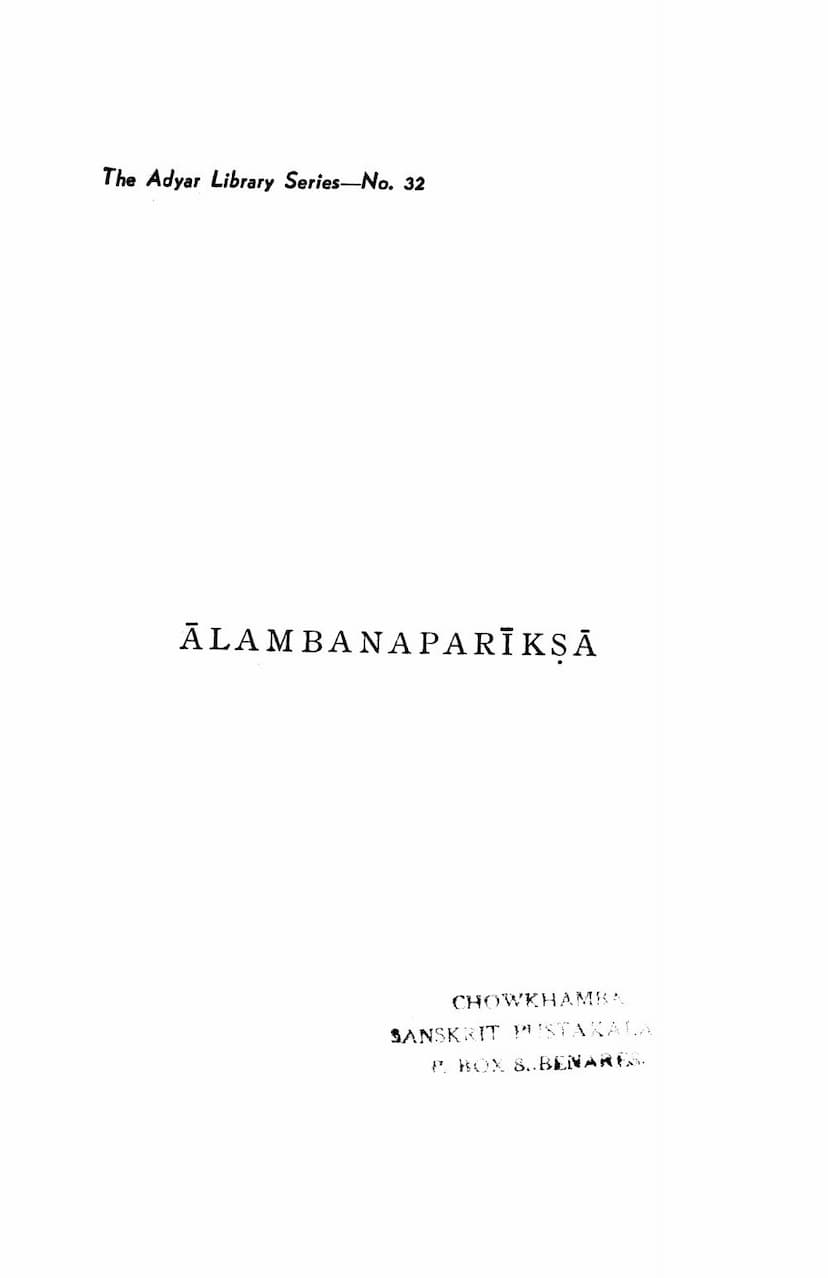Alamban Pariksha
Added to library: September 1, 2025

Summary
Here's a comprehensive summary of the Jain text "Alambanapariksha" by Dignāga, based on the provided materials:
Book Title: Ālambanaparīkṣā and Vṛtti Author: Ācārya Dignāga Commentary: Dharmapāla Editor: N. Aiyaswami Sastri Publisher: Adyar Library Publication Year: 1942
I. Introduction and Context:
- Ālambanaparīkṣā is a significant Buddhist treatise by Ācārya Dignāga, considered the "father of medieval Indian logic."
- The work's Sanskrit original is lost, but it has been preserved and reconstructed from Tibetan and Chinese versions.
- This edition is a scholarly effort to restore the Sanskrit text, providing commentaries and translations to make it accessible to modern scholars.
- Dignāga, a key figure in the Yogācāra school of Buddhism, presents the arguments from a philosophical and logical perspective, which were met with significant criticism from Brahmanical thinkers like Kumārilabhatta and Sankarācārya.
II. Core Argument and Philosophical Stance:
- Central Inquiry: The treatise primarily investigates the true nature of ālambana, which refers to the "object" or "object-cause" of consciousness.
- Dignāga's Thesis: Dignāga, building upon the Yogācāra idealist stance, argues that external things, as perceived by consciousness, are ultimately unreal. Consciousness itself is the sole reality.
- Critique of Realists: Dignāga thoroughly examines and refutes the positions of realists, including the Vaibhāșikas, Vaiśeṣikas, and others who posit the existence of external, independently real objects.
- Yogācāra Explanation: According to Yogācāras, only pure consciousness appears as both the subject and the object. External entities are not independently real. The cause of consciousness arising is its own knowable aspect (grahya-bhāga), which acts as the ālambana-pratyaya (object-cause).
- Key Logical Points: Dignāga addresses the objection of how a part of consciousness, appearing simultaneously, can be a condition for consciousness itself. He offers two answers:
- Simultaneous Condition: It is a condition because it is invariably associated with consciousness (pratyayo 'vyabhicāritvāt saha).
- Successive Condition: It acts as a condition in succession by transmitting its force (śakti) (śaktyarpaṇāt kramāt).
III. Structure and Content of the Edition:
The Adyar Library edition is comprehensive, featuring:
- Restored Sanskrit Text: The original text of the Ālambanaparīkṣā with Dignāga's own Vṛtti (commentary).
- Chinese Versions: Literal Sanskrit renderings of Paramārtha's and Hiuen Tsang's Chinese translations, presented in parallel columns.
- Dharmapāla's Commentary: The Sanskrit text of Dharmapāla's commentary, along with an English translation. This commentary is particularly important, though noted as incomplete.
- Vinitadeva's Commentary: Copious extracts from Vinitadeva's commentary, translated into English and incorporated as notes to the main text. Vinitadeva's commentary is described as learned and helpful.
- Tibetan Version: A Romanized Tibetan version of the text for beginners.
- Additional Notes and Appendices: These provide valuable context, discussing Vasubandhu and Sthiramati on externalism, a classification of dharmas by Yogācāras, and Sautrāntikas' classifications.
IV. Dignāga's Refutation of External Realities (Key Arguments):
Dignāga systematically dismantles the arguments for the existence of external objects by critiquing various realist positions:
- Atoms (Paramāṇu):
- Atoms, though potentially causes of consciousness, lack the form that consciousness experiences. Consciousness cognizes its own forms, not the inherent nature of atoms.
- Atoms are too subtle and lack the gross forms required for direct apprehension by the senses.
- Attributes like solidity or hardness in atoms, though real, are not objects of visual consciousness because consciousness lacks the corresponding forms.
- Aggregates of Atoms (Sanghāta):
- Aggregates lack substantial existence (dravyataḥ asatva), similar to the perception of a double moon due to sensory defect.
- If aggregates are real, they would have to possess distinct forms or parts. However, atoms themselves lack differentiation in form and size.
- The substantiality of aggregates is questioned because if one removes constituent atoms, the aggregate's perceived form vanishes, suggesting its conventional, not absolute, reality.
- The combination of atoms itself is an attributed form, not a real substance, and thus not a direct object of senses.
- Critique of "Combined Form" (Sañcitākāra):
- The idea that atoms possess a "combined form" (sañcitākāra) is analyzed. While aggregates may appear as gross forms, Dignāga argues this is a conventional attribution and not inherent to atoms themselves.
- The argument for a "combined form" being an object is challenged because if it's a mere conventional appearance, it cannot be an independently real object-cause.
V. Dharmapala's Commentary and Vinitadeva's Extracts:
- Dharmapāla's Contribution: Dharmapāla clarifies Dignāga's arguments, addressing the nature of mind (manas) as the sixth sense and its distinctness from sensual consciousness, emphasizing the subjective nature of experienced objects. He discusses the limitations of the mind, which, lacking substantiality, cannot be a real object-cause.
- Vinitadeva's Insights: Vinitadeva's commentary offers further explanations, particularly on the concepts of force (śakti) and the reciprocal conditioning of consciousness and its perceived forms. He highlights the impossibility of independent external objects and the ultimately subjective origin of our perceived reality.
VI. Significance and Impact:
- Logical Foundation for Yogācāra: Dignāga's Ālambanaparīkṣā is crucial for its logical rigor in establishing the Yogācāra tenet of vijñaptimātra (consciousness-only).
- Influence and Debate: The work sparked significant debate among Indian philosophers, with strong counter-arguments presented by thinkers from other schools, showcasing its intellectual impact.
- Cultural Bridge: The reconstruction from Tibetan and Chinese versions underscores the historical transmission of Buddhist thought and the importance of these languages for preserving lost Sanskrit texts.
In essence, the Ālambanaparīkṣā is a foundational text in Buddhist logic and epistemology, meticulously dissecting the concept of the object of consciousness to argue for an idealist worldview where reality is ultimately rooted in consciousness itself.